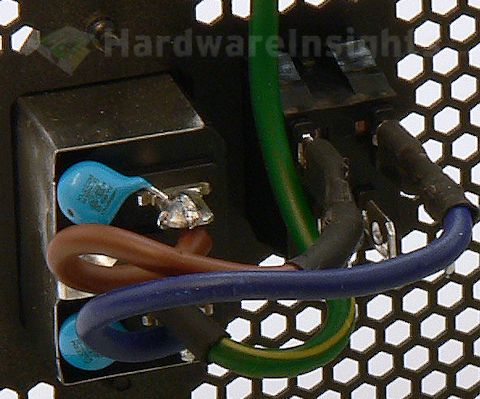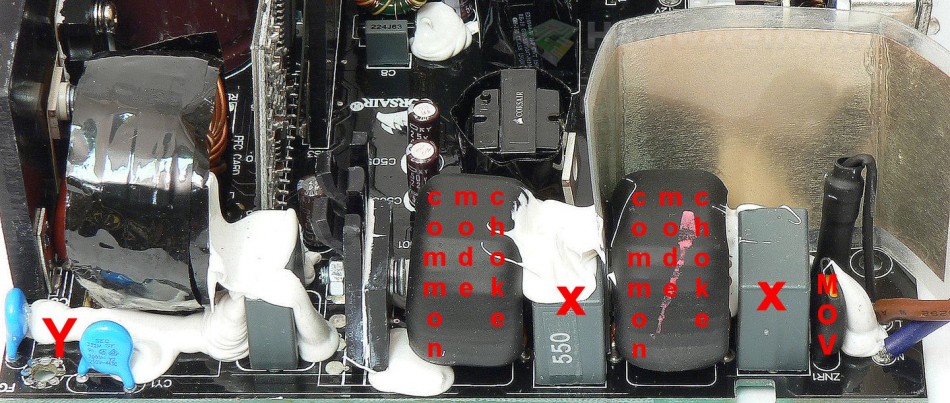Contents
- 1Introduction
- 1.1Packaging and accessories
- 2Connectors & cabling
- 2.1Casing & cooling
- 3Input filtering
- 4Primary side
- 4.1+5 V stand-by rail
- 5Secondary side
- 5.1Build quality
- 6Load testing
- 6.1Loading +5 V SB
- 6.2Voltage hold-up time
- 6.3Combined loading
- 6.4Combined loading ripple
- 6.5Crossloading, overloading
- 6.6Crossloading, overloading ripple
- 6.7Fan speed and temperatures
- 7Conclusion and evaluation
- 7.1Thanks
- 7.2Discussion
Input filtering
The input filtration – as usual – starts directly on the AC inlet with two ceramic Y capacitors. The inlet itself is partially shielded. Cables are connected by fastons to the two-pole switch.
Then there are two more Y caps on the main board (and fifth between primary and secondary sides) together with two X film caps, and two common-mode chokes, both sleeved with heatshrink. The varistor is directly next to the input fuse, thermistor (with no extra insulation) in front of the big primary capacitor. There is also a copper foil in there, however, it is not grounded so its EMI suppression capabilities will be limited. There is no thermistor relay bypass nor any X cap intelligent discharge IC (though there is spot for relay on the board). There is actually not even any bleeder resistor for the X capacitors. There are however two rectifying diodes to supply stand-by rail controller which should act as a bleeder – if it does not fail. This is not an uncommon failure mode and then the unit may get dangerous. However, similar questions could be asked about all the X-cap dischargers so I will leave this be as it is.
X capacitors (between phase and neutral) and Y (between phase and ground/neutral and ground, often also between one side of the high-voltage DC and ground) are used to filter out high-frequency ripple from power grid (often from devices which lack filtration because of cost cutting, but also from devices where filtration is very difficult to implement) and also keeps ripple from this unit from entering the grid. Chokes are used for the same reason, together they form an input filter. These components may also (partially) help to filter smaller voltages spikes in the power grid while the MOV is used to suppress more serious spikes (for example from lightning hitting the power grid at a distance). These days, more Y capacitors are used even between rectified ground (ground after an input rectifier) and earth ground to suppress internal interference and keep it from getting to secondary side, because really high-frequency ripple goes everywhere it can to some extent (including coupling through the insulation, metal casing etc.). That is also why the AC wires themselves are often inserted through the ferrite core.



